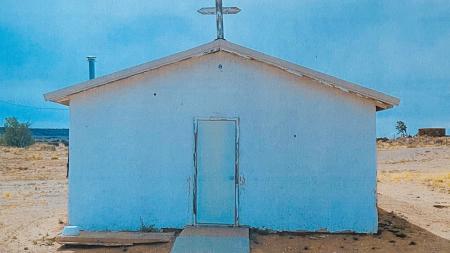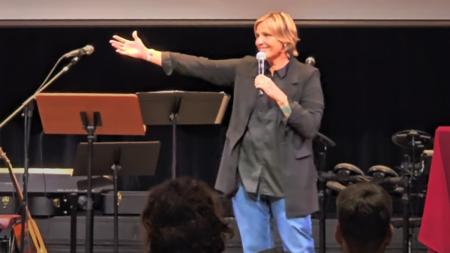Gathering Everyone Together

Since early January, Irene Kraegel has been helping to facilitate Together, a new inclusive Bible study from Friendship Ministries, for a small group of adults at Grace Christian Reformed Church in Grand Rapids, Mich.
Meeting for an hour before the Sunday service, the group is made up of a range of people from different backgrounds and levels of education — and that diversity is what Together is all about.
“We have found the study helpful in building relationships between people in our church who might not normally interact with one another, particularly when those divides are related to reading ability, educational level, or cognitive functioning,” said Kraegel.
“There’s a more relaxed atmosphere in Sunday school as compared to past studies — there is laughter and connection and growth happening.”
For some 30 years, Friendship Ministries has made Friendship curricula available for Bible study and other instruction that includes large group activities and also connects each person with intellectual disability with a mentor. The groups often meet once a week to proceed through the units. Hundreds of Friendship groups worldwide have formed out of these connections.
About three years ago, representatives of Friendship and the CRC met to discuss developing additional curricula for Friendship groups.
At that time, they decided to allow the existing Friendship print materials to gradually go out of print, and to create Together as an online curriculum that maintains a focus on inclusive learning.
Together offers lessons that have been developed in two formats — one version for traditional Friendship groups and a more inclusive version for small groups in which adults of all kinds of abilities can participate.
“We had the vision of leading the church into something different in which adults of all abilities could grow together. It was a real group effort,” said Barbara Newman, who helped to spearhead development of the new program and to write some of the material.
Newman, author of Accessible Gospel, Inclusive Worship, said the new Bible study came out of the concept of Universal Design, which teaches that access to the gospel message should be available to all people in all aspects of worship and church life.
In order to include this concept in small-group studies, said Newman, they needed to go beyond traditional models of people gathering to mainly read words from a page or watch a speaker on a video and discuss Scripture together.
Instead, given that persons with intellectual challenges may not be able to read or, if they can, may find that it isn’t the best way for them to learn, the curriculum planners ventured into providing materials that would have a universal appeal.
Using a variety of video formats, songs, take-home assignments, photographs, artwork, recorded voices, and the opportunity for role-playing as characters in Bible passages, the small-group studies provide a multimedia learning experience for a diversity of participants in any one group.
One of the sessions in the Bible study unit titled Choose Courage, for instance, describes how God held back the Jordan River, which was at flood stage, so that the priests from Israel could carry the ark of the covenant across on dry land.
“This lesson begins by looking at an introduction comparing different rivers, what they look like and what you might enjoy doing in those rivers,” said Newman.
Based on Joshua 3, the activity features photos of people swimming, paddling canoes, and whitewater rafting.
After viewing those photos, participants are invited to give a thumbs-up or thumbs-down to answer whether they have ever done one of those activities.
Next, the group views a photo of a roiling river at flood stage to give everyone a concrete idea of what the flooded Jordan may have looked like to the priests who were ready to carry the ark into the promised land.
Recounting the message of this lesson, Newman said that as they stood on the river bank, the priests may have thought “they were making a big mistake.”
But, according to the lesson, “they were actually obeying God. Holding that ark must have made them more courageous. Stepping out in faith into the water, [which then parted,] they knew that God was with them.”
Throughout this session as well as others, there is ample time to discuss what participants have seen and heard — and also to use their imaginations to pictures themselves in the story, such as what it felt like to walk across that cold river bottom, just recently drained of floodwater. While the message of Scripture remains the same as it always has been, the way it is presented can help participants learn from and live into it in fresh ways.
“We believe Together levels the playing field for people in a small group. Everyone has a chance to understand what is going on and to participate. It is a powerful time as so many different people engage in learning from and with one another,” said Newman.
About 20 percent of people in North America have some type of disability, meaning there is a good chance in any church — as well as in the surrounding community — that there are members and neighbors who would love to be part of an adult small group but feel that they don't belong.
“It's an exciting project because it has the potential to include many types of people who were previously left out — not only people with cognitive disability, but also people who are bipolar, have ADHD, have poor reading skills, and so on,” said Ruth Vander Hart, an editor on the project.
Newman was, in fact, amazed at how well Together worked when she tried it with a group of people with dementia — after someone asked her if the material could help people with memory struggles.
“In using it with a group of seniors with dementia, I saw how all of the rich visual components, as well as the music, allow people to have access to the content without having words for it,” she said.
One man, who could barely speak in conversation, heard a certain prayer and was immediately able to recite that prayer; another person burst into song upon hearing familiar music played. Others smiled and even danced a little to the music. Somehow familiar images, phrases, and music tapped into the memory banks of persons with dementia.
“Right now I’m working on a resource that will help churches adapt Together for use with people with dementia,” said Newman, a special education teacher who works as the director of the CLC Network.
Besides Choose Courage, other units focus on Jesus: Face to Face, Unwrapping Your Gifts, Living with Pain, Pray.!? and the season of Christmas. Coming up soon will be units on Living in Community, The Long Haul God, and the Road to Jerusalem (Lent).
In many ways, churches using Together are helping to pioneer a small-group program that promises to help bring the church closer to what Christ wants it to be.
“This is a very new idea for groups of adults. But I think its philosophy and approach are at the very heart of who we should be as a church — one family in Christ,” said Kraegel of Grace CRC.
According to materials promoting Together: “This is a very new idea for groups of adults. It is a philosophy and approach that are at the very heart of who we should be as a church — one family in Christ.”


